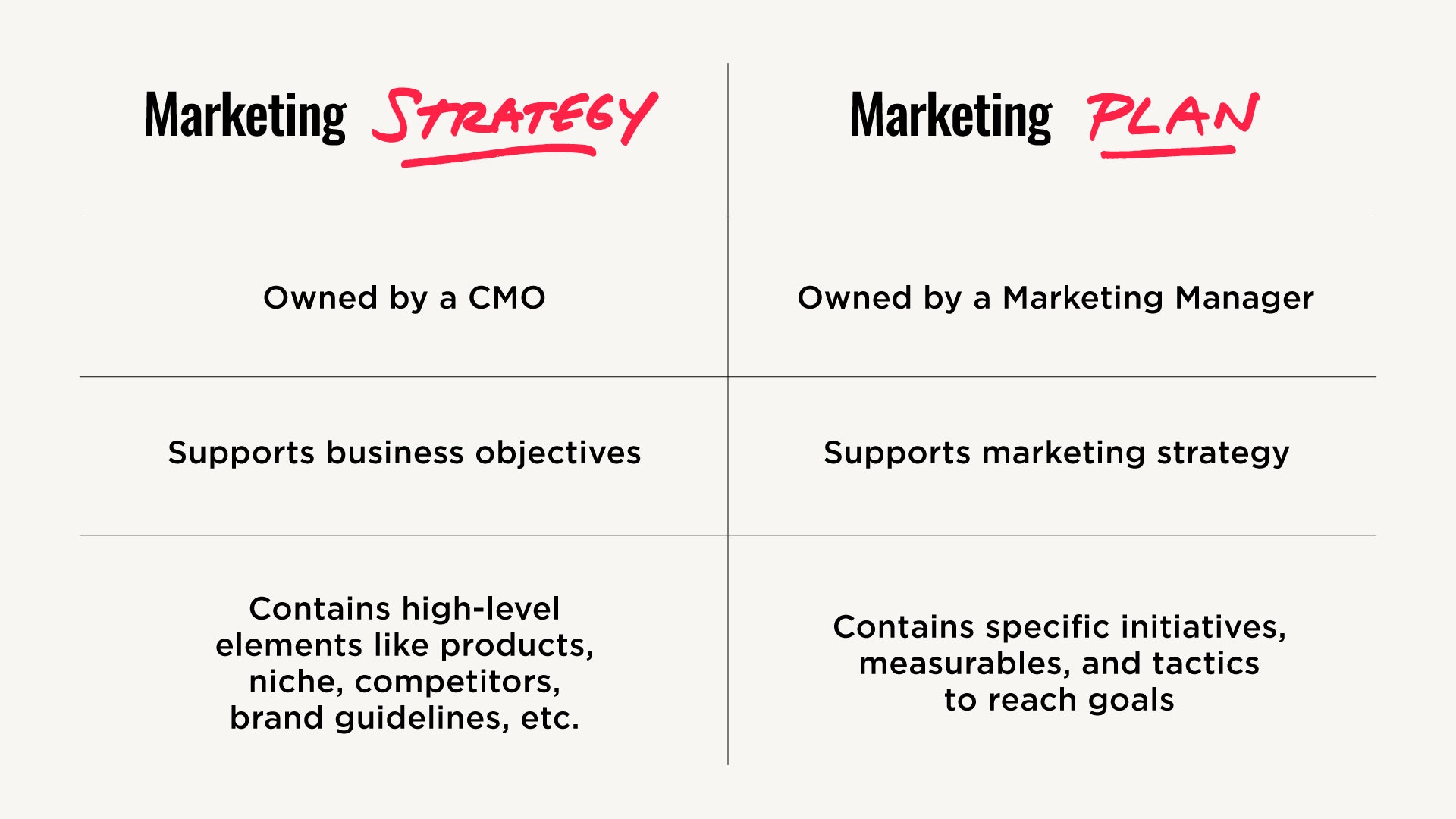Marketing plan. Marketing strategy. Marketing vision.
These words tend to be tossed around casually by marketers and executives alike. The only problem is, it’s not always clear what a marketing strategy or plan should look like—and what purpose each serves.
As someone who loves addressing the question everyone is thinking but no one is asking, I thought it would be good to clarify the differences between a marketing strategy and a marketing plan, what each one contains, and some advice for bringing both to life.
Quick note: if you’re looking for a holistic marketing toolkit to organize your thoughts—we have you covered. It’s free, it helps you document your thoughts, and it’s filled with some great resources to make you a better marketer.
Now let’s get into it.
What Is a Marketing Strategy?
A marketing strategy is a document that answers the big questions—what you offer, who your audience is, what your company stands for, brand guidelines, what niche or industry you play in, and who your main competitors are. It can include less or more information than that, but its purpose is to be a sort of lighthouse, helping you keep your marketing focused on the bigger picture.
Marketing strategies are always rooted in what your overarching business goals are. If your business needs to increase revenue by 25%, then your marketing strategy would explain how marketing will help achieve those goals from a high-level point of view.
When writing a marketing strategy, do not—I repeat—DO NOT go into uber-specific marketing tactics. That’s for later. On the flip side, you should be asking the right kinds of questions.
What Is a Marketing Plan?
Your marketing plan, based on your marketing strategy, dives into the specifics—what channels and tactics you’re using, which segment of the audience you’re targeting, when initiatives are occurring, and how you’ll measure success.
Compared to your marketing strategy, your marketing plan is more about which tactics, campaigns, initiatives, and promotions you’ll run in a certain amount of time. Marketing plans can range from three months to a year, and should remain semi-flexible in case marketing needs to shift priorities.
Marketing Strategy vs. Marketing Plan
To help visualize all of this, we’ve created a graphic that explains the core differences between a marketing strategy and a marketing plan.
In our experience, the marketing strategy shouldn’t change as much as your marketing plan. If it does, it’s almost impossible to gain any real traction or measure the impact of your marketing on the business. That said, you’ll probably need to revisit your marketing strategy each year, whereas you’ll be executing against your marketing plan regularly.
At this point, you might be thinking, “this seems like A LOT.” It is, which is why strategies and plans are often broken down into smaller disciplines within marketing (think: content, customer acquisition, customer retention, and more). Let’s look at an example.
An Example in Action: Content Marketing
Most marketers are familiar with content marketing, so let’s use it as an example. Like I mentioned earlier, strategies address high-level issues whereas plans show how you’re going to execute.
Content Marketing Strategy
In this case, your content marketing strategy would answer those big questions discussed above. Questions like:
- Who should we be writing to?
- How will content marketing support our business goals?
- How much money can we spend on creating content?
- Who are our content competitors?
- What tone do we want to come across in our content?
The role of the content marketing strategy isn’t to point out every single topic you’re going to write about or even what your specific KPIs for the upcoming year are going to be. Instead, it’s supposed to give context to why you’re investing in content marketing, who you’re targeting, what content mediums you’re going to use (generally), and more.
Content Marketing Plan
Once you have your strategy set, your content marketing plan should explain how you’re going to attack the problem. This is where you’ll document content marketing goals and KPIs, what resources you plan on creating, when you plan on creating them, who will be involved in the process, how you’ll be promoting each piece of content, and more.
There’s more to content marketing plans than an editorial calendar, but your editorial calendar is a huge part of your plan. It tells everyone what topics your content is addressing, where it’s being published, when it’s being published, which channels you’ll promote it through, and the goals it should be aiming to hit.
Tips for Creating a Stellar Marketing Strategy or Plan
Whether you’re focusing on the overarching strategy or getting into the fine details, there are a few things you need to keep in mind throughout the journey that will help produce something of real value for your organization or team.
Tip #1: Document Your Plan/Strategy
This sounds obvious, but it is oh-so important. Enter impactful stat—marketers who document strategy are 538% more likely to report success than those who don’t. That’s a real number. Write your plan down. Even if you don’t think it’s 100% correct.
As marketers, we want so desperately to get everything right that it often has the opposite effect—we’re paralyzed. You can go back and adjust your plan or strategy as necessary, but it starts with actually having a plan or strategy. Plus, without a documented vision for the future, it’s much harder to gain buy-in from your co-workers and miscommunication ensues.
Tip #2: Collaborate with Others
You don’t have to do this alone. Nor should you. Even if you’re legitimately the only person in your marketing department, you can ask your marketing friends at different companies for some insight. If all your friends sadly work in sales (jk, jk) you can even gain some perspective from co-workers in different departments. They might not give you the best “marketing” ideas, but they might ask good questions and prove to be good sounding boards.
There are tons of positives when it comes to collaborating with others. A few I like are gaining new perspectives, considering other ways to solve the problem at hand, gaining feedback, and the efficiencies that come with asking people that may have done something similar in the past.
Tip #3: Make It Clear. Make It Realistic.
There’s no problem shooting for the moon. But if you create a marketing plan or strategy that requires 10 people to execute and you only have two sad interns, then it’s not all that helpful. You’ll just end up with a ton of ideas but no idea which ones to work through.
A wise person once said, “The essence of strategy is choosing what not to do.” Try your best to paint a clear picture that’s based in reality.
Don’t Let the Scary Marketing “Strategies” Overwhelm You
To play on even more cliches, “A journey of a thousand miles begins with a single step.” Try your best to avoid paralysis by analysis, and instead tackle your strategy or plan one step at a time.
And if you don’t think documenting your marketing plan or strategy is important, think again. Remember: marketers who document strategy are 538%(!) more likely to report success than those who don’t.
Finally, one last reminder that for those who can’t wait to dig in and start planning, we created a marketing toolkit that allows you to work through building your very own marketing strategy. Happy planning!







